Returning to the mainstream from the outcast of the times: What has the 'secondary screen' of smartphones been through?
On October 31, 2018, SoftPai Technology released the world's first consumer-grade folding screen smartphone "FlexPai SoftPai", opening up a new era of folding screen smartphones, which was listed as one of the top five trending products in the world for CES 2019 published by Forbes, opening up the precedent of folding screen devices; on February 28, 2019, Samsung released its first folding screen in Wuzhen smartphone, the Galaxy Fold, a launch that marked the beginning of a move from a forward-looking concept to a practical phase for folding screen smartphones. After FlexPai and Galaxy Fold, similar products also entered the well, and manufacturers with a certain level of R&D in the industry have launched their own folding screen products, hoping to seize this piece of unexplored virgin land.
The two products from Zoyu Technologies and Samsung represent two ideas for folding screen solutions, namely external folding and internal folding. After four years of sifting through the market, the vast majority of folding screen products currently on sale have adopted the relatively higher ease of use and reliability of the internal folio solution, and the rise of such folding screen phones has brought back a concept that has long been decoupled from the times: the secondary screen.
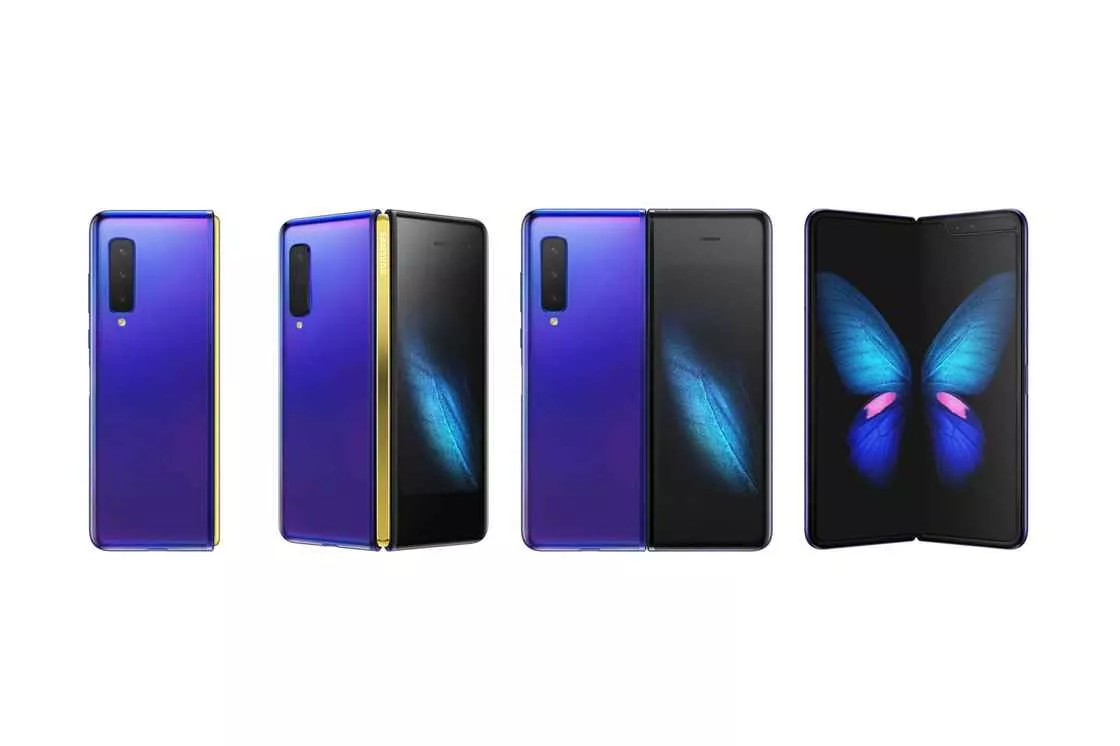 The "external screen + internal fold" has become the mainstream of folding screen products Unlike personal computers, mobile phones as mobile devices usually do not need a second screen The Compared with the input devices used in computers, such as keys and mice, mobile phones are more intuitive, and the extra screen in most cases will not only fail to improve the efficiency of mobile phone users' input, but will also be lost because of the difference in display content and operation, which is "not strong perception, increase power consumption, wrong direction". Therefore, the secondary screen is usually used as an unconventional design to mend missing functions or to add to existing functions. That said, the history of mobile phone development in the past three decades has seen a number of deviant works that use the secondary screen as a selling point, and some have even broken through the shackles of mobile devices to become a generation of classics.
The "external screen + internal fold" has become the mainstream of folding screen products Unlike personal computers, mobile phones as mobile devices usually do not need a second screen The Compared with the input devices used in computers, such as keys and mice, mobile phones are more intuitive, and the extra screen in most cases will not only fail to improve the efficiency of mobile phone users' input, but will also be lost because of the difference in display content and operation, which is "not strong perception, increase power consumption, wrong direction". Therefore, the secondary screen is usually used as an unconventional design to mend missing functions or to add to existing functions. That said, the history of mobile phone development in the past three decades has seen a number of deviant works that use the secondary screen as a selling point, and some have even broken through the shackles of mobile devices to become a generation of classics.
Some phones dream of becoming computers
People have always wanted a handheld terminal that could completely replace a PC, from the early days of PDAs to the red-hot UMPCs to the current 2-in-1 devices and so-called Windows handhelds, and while that wish hasn't been fully realized, we still think, "Come on, it's cool to have a computer that fits in your pants pocket!
There is one thing to say, indeed.
Nokia 9000 Communicator
On August 15, 1996, communications giant Nokia launched the first product in its Communicator line of "smartphones": the Nokia 9000.
The Nokia 9000 gained a lot of attention when it was launched, not only because of its network access and email capabilities, but also because of its laptop-like design. The poor little screen and T9 keyboard combination on the front is just an 'accessory' for making and receiving calls.
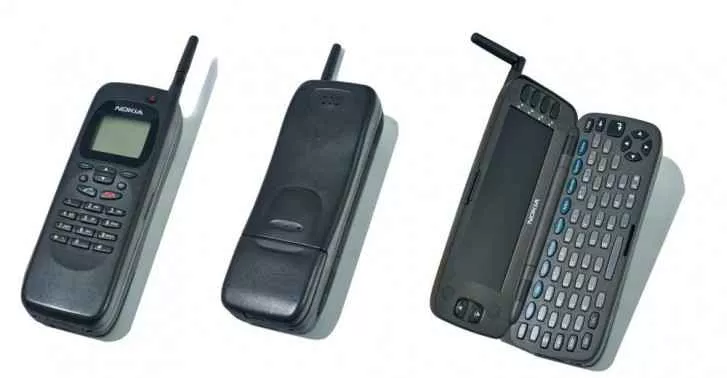 Nokia 9000 Form FactorIf you look at the hardware configuration alone, the Nokia 9000 is not really related to a mobile phone: it is powered by an Intel 80386EX processor with 24MHz of RAM and 4MB of storage. The Intel 80386EX processor from Intel, clocked at 24MHz, with 4MB of RAM and 4MB of storage, is capable of matching or even surpassing the performance of any PC of its time. This operating system provided users with an Office-like text office suite, a graphical email client, and a web browser, which basically fulfilled all the imaginations of users at that time about the new "handheld computer".
Nokia 9000 Form FactorIf you look at the hardware configuration alone, the Nokia 9000 is not really related to a mobile phone: it is powered by an Intel 80386EX processor with 24MHz of RAM and 4MB of storage. The Intel 80386EX processor from Intel, clocked at 24MHz, with 4MB of RAM and 4MB of storage, is capable of matching or even surpassing the performance of any PC of its time. This operating system provided users with an Office-like text office suite, a graphical email client, and a web browser, which basically fulfilled all the imaginations of users at that time about the new "handheld computer".
Essentially, the Nokia 9000 is a miniaturized PC and a mobile phone stitched together, with the "phone" on the front and the "computer" on the inside sharing a single set of hardware, but hardly interacting with each other, and this "well and water" relationship is considered to be their own. In a time when mobile devices were still in the era of the great sea, the Nokia 9000's seemingly simple and brutal approach was indeed more pragmatic than forcing dual-screen interaction into an over-the-top design.
Nokia E90 Communicator
Nokia's Communicator series continued into 2007, but by this time the Communicator was no longer a separate product line, but was incorporated into the E series as a business flagship and served as a super-sized cup. On February 12, 2007, the Nokia E90 Communicator made its debut at the Mobile World Congress in Barcelona, Spain, with the family design of every Communicator generation, but with the modern style of the E-Series.
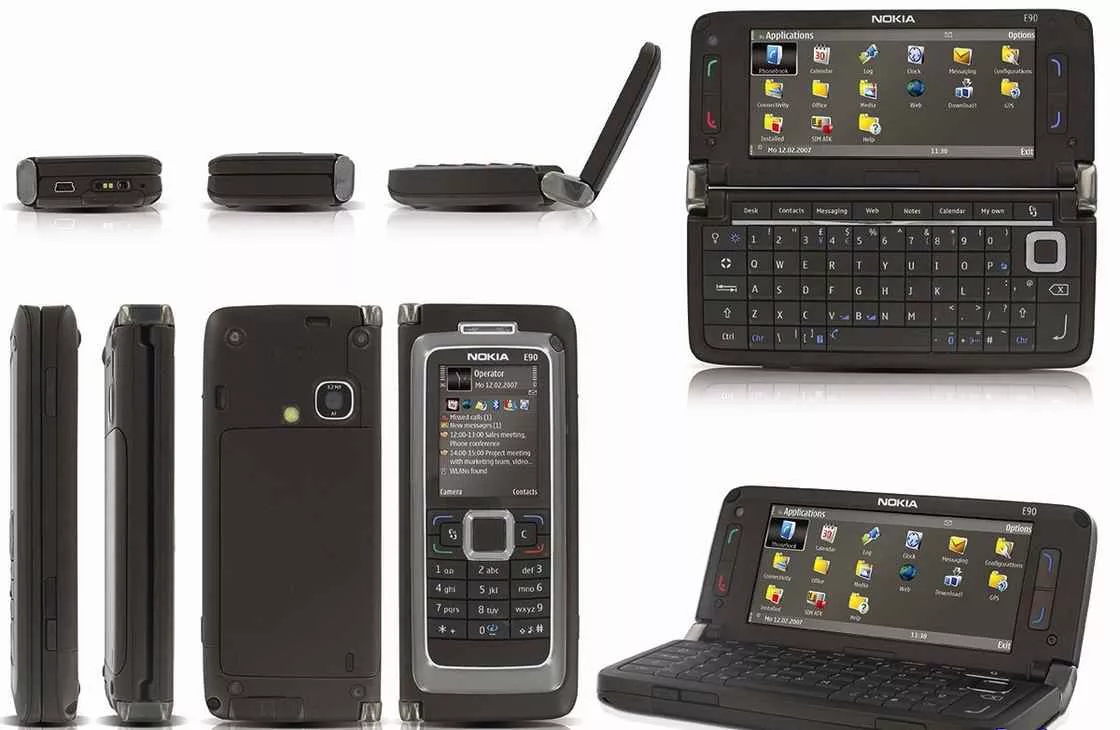 The Nokia E90 takes on the mantle of the Nokia 9000, probably the only mobile device in 2007 that delivers an 'ultra widescreen' experience. The Nokia E90 is built around the latest Symbian S60V3 operating system, so the external secondary screen, which was originally an 'accessory', also gets the full smartphone experience. The slender home screen also supports splitting the display of some system applications by level, which is similar to the in-app split screen feature now common on tablets.
The Nokia E90 takes on the mantle of the Nokia 9000, probably the only mobile device in 2007 that delivers an 'ultra widescreen' experience. The Nokia E90 is built around the latest Symbian S60V3 operating system, so the external secondary screen, which was originally an 'accessory', also gets the full smartphone experience. The slender home screen also supports splitting the display of some system applications by level, which is similar to the in-app split screen feature now common on tablets.
It's easy to see that the Nokia E90 was the result of historical limitations: Nokia didn't see the touchscreen era coming so quickly, and the then-advanced Symbian OS wasn't ready to face modern mobile operating systems like iOS and Android until S60V5 a year later. So the Nokia E90 became the end of the Communicator series of classic designs, and Nokia hasn't released a '2-in-1' device with such a high level of finish since.
LG KT610
In 2008, LG launched the KT610, the second smartphone with Symbian S60V3, which was similar in design to the Nokia E90, but the secondary screen was cut in half in size and functionality. The KT610 was similar in design to the Nokia E90, but the size and functionality of the secondary screen was drastically cut out, leaving almost only quick functions such as photo and multimedia control, in addition to phone calls and SMS.
Unlike the Nokia E90, which is a business flagship, the KT610 is an entry-level smartphone with multimedia as its selling point. Its side-fold design focuses not on providing assistance for advanced functions such as document editing and web browsing, but on providing a more comfortable viewing experience for multimedia playback and GPS navigation. While this sacrifices the full extent of the secondary screen, the KT610 is undoubtedly a more mature product when judged on price and ease of use.
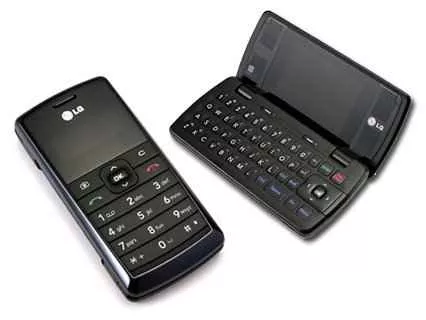 The front of the LG KT610 is rather retro looking, and doesn't even look like it would have been around in 2008. Although the KT610 focused on multimedia, the overly affordable price tag at the time also resulted in a slightly shabby hardware configuration that couldn't perform to its full capacity: video decoding performance was barely adequate, and the dual front-facing speakers were just a level to hear. Other than that, the KT610's photography is the biggest design flaw: the 2-megapixel camera isn't exactly outdated in 2008, but the autofocus, digital stabilization and flash that were standard back then are as neatly pigeonholed as a minority author's. The KT610 can use the secondary screen when taking photos. The KT610's camera is easily obscured by the fingers when held horizontally, making it a bit of a no-brainer to use if the main screen inside is used as a viewfinder. But LG has since released a couple of similarly designed phones, perhaps because it doesn't want to waste the line, or to be optimistic: sales of the KT610 have been more than satisfactory.
The front of the LG KT610 is rather retro looking, and doesn't even look like it would have been around in 2008. Although the KT610 focused on multimedia, the overly affordable price tag at the time also resulted in a slightly shabby hardware configuration that couldn't perform to its full capacity: video decoding performance was barely adequate, and the dual front-facing speakers were just a level to hear. Other than that, the KT610's photography is the biggest design flaw: the 2-megapixel camera isn't exactly outdated in 2008, but the autofocus, digital stabilization and flash that were standard back then are as neatly pigeonholed as a minority author's. The KT610 can use the secondary screen when taking photos. The KT610's camera is easily obscured by the fingers when held horizontally, making it a bit of a no-brainer to use if the main screen inside is used as a viewfinder. But LG has since released a couple of similarly designed phones, perhaps because it doesn't want to waste the line, or to be optimistic: sales of the KT610 have been more than satisfactory.
There are computers that just want to be a phone
On the eve of the dawn of the smartphone, there was a special class of "deformable" devices, whose design combined the features of traditional mobile phones and modern smartphones, and could be seen as the manufacturers' exploration of the future of mobile devices in the transition zone from keyboard to touch screen. Now, these so-called 'handhelds' may seem a bit unconventional, but these products also represent the possible direction of smartphone development.
Ericsson R380SC
In 1998, the WAP standard was announced, and in 1999, WAP became commercially available, with all the major manufacturers launching their own WAP phones in time for the millennium, including Ericsson, which was still a giant in the communications industry.
In 2000, Ericsson launched a series of WAP-enabled phones, of which the R380SC was definitely the most notable: although the R380SC only had a single-touch monochrome resistive touch screen, Ericsson's clever design combined the T9 keyboard with the lower flip cover to "disguise" it as a conventional phone when it was tucked away to cater to users' regular functions such as phone calls and text messages. In its 'full' form with the flip cover open, the R380SC is a true business PDA, the world's first smartphone with Symbian OS and an impressive range of built-in applications that can be switched between two modes of display and operation.
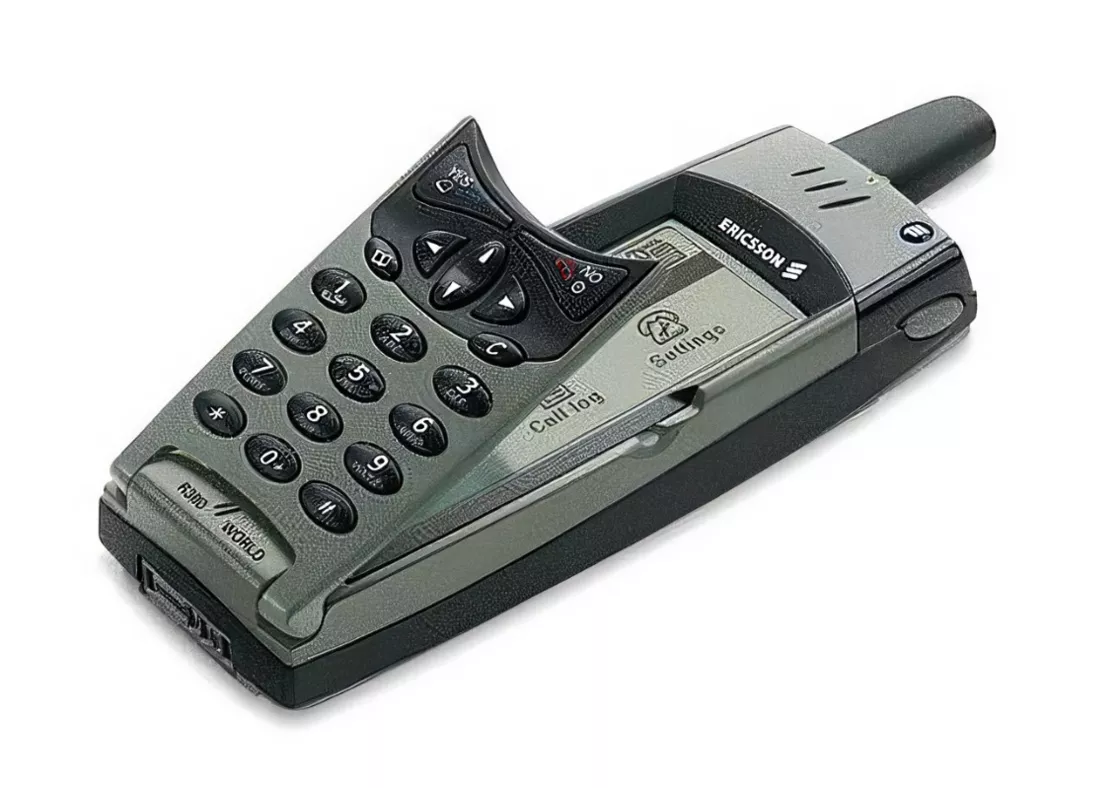 R380SC is more like a prop in a spy movie, although the Ericsson R380SC doesn't really have a "secondary screen" in the true sense of the word. Although the Ericsson R380SC doesn't really have a "secondary screen" in the true sense of the word, the secondary screen mode, which is extended by a combination of hardware and software, does provide a relatively complete user experience at a time when touchscreen technology is not yet ready. If the emergence of sub-screens was generally a compromise of concept to technology, the R380SC's counter-intuitive design certainly represents a rare spirit of exploration in its time, and was continued in the P800 and P900 models launched after the merger of Ericsson and Sony's mobile phone divisions to form Sony Ericsson.
R380SC is more like a prop in a spy movie, although the Ericsson R380SC doesn't really have a "secondary screen" in the true sense of the word. Although the Ericsson R380SC doesn't really have a "secondary screen" in the true sense of the word, the secondary screen mode, which is extended by a combination of hardware and software, does provide a relatively complete user experience at a time when touchscreen technology is not yet ready. If the emergence of sub-screens was generally a compromise of concept to technology, the R380SC's counter-intuitive design certainly represents a rare spirit of exploration in its time, and was continued in the P800 and P900 models launched after the merger of Ericsson and Sony's mobile phone divisions to form Sony Ericsson.
Motorola A780
In 2004, Motorola introduced the so-called "two-key" A780, which at first glance looked just like the Ericsson R380SC: the same flip keypad layout, the same switchable "key+touch" mode, except the R380SC looked more like a straight phone that opened up. The R380SC looks more like a straight phone that opens up, while the A780 looks like a flip phone with a small screen and matching T9 keyboard tucked into the A-side.
Although it looks quite similar, the design concept of the A780 is not exactly the same as that of the R380SC: the A780's secondary screen is designed to allow users to handle instant messages more quickly than using the touch screen, and it takes over and optimizes a small part of the main screen's functions in order to improve operational efficiency, rather than providing a transition zone for users' operating habits. The A780's two display modes share a set of function keys, so Motorola's approach to the touch screen is still relatively conservative.
 The Motorola A780 even uses a pointing stick instead of arrow keys, which is actually optimized for the touch screen. The A780's biggest feature is its embedded Linux operating system, which supports J2ME extensions, and its ability to expand functionality by installing applications; another major advantage of the Linux system is the A780's leading-edge handwriting recognition technology - especially for Chinese. This feature has been a major selling point of the A series for generations, with the "Ming" series, pioneered by the A1200, being the model for this type of smartphone.
The Motorola A780 even uses a pointing stick instead of arrow keys, which is actually optimized for the touch screen. The A780's biggest feature is its embedded Linux operating system, which supports J2ME extensions, and its ability to expand functionality by installing applications; another major advantage of the Linux system is the A780's leading-edge handwriting recognition technology - especially for Chinese. This feature has been a major selling point of the A series for generations, with the "Ming" series, pioneered by the A1200, being the model for this type of smartphone.
Motorola A1200 "Ming"
Many of you may have seen the advertisement for the so-called "Voice King" phone on TV shopping channels more than a decade ago, but few of you know where the so-called "luxury sports car styling" in the advertisement was taken from. In fact, this series of business models is modeled after Motorola's "Ming" series of smartphones launched in February 2006, and the A1200, the first of the series, is naturally the most representative one.
The biggest difference between the A1200 and its predecessor is the complete disappearance of the T9 button and screen window on the flip cover, which is replaced by a full, almost transparent flap. Unlike the A780's shortcut-oriented sub-screen mode, this cover is really more about protecting the delicate resistive touchscreen underneath. Without the T9 keyboard, there's no way to make calls or edit text messages, but users can still rely on a wealth of side buttons to answer calls, assign contacts to dial numbers, reply to messages with preset phrases, take quick photos and control multimedia, and because the A1200 has more features of its own, this essentially scaled-down secondary mode is actually a bit stronger than the A780's.
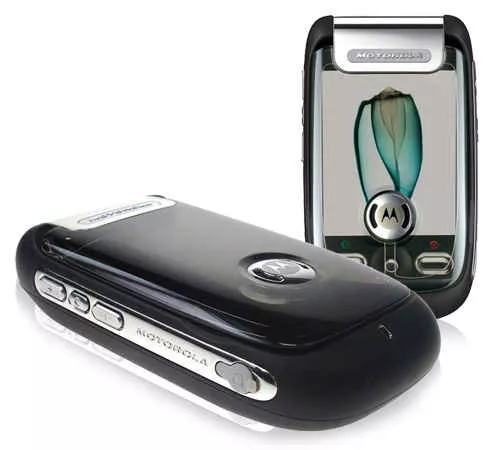 The Motorola A1200 is very rounded in its tucked away state and is said to be inspired by pebbles, which is a bit of a "made for you, made in heaven" flavor. The A1200's operating system is also based on a Linux kernel with excellent scalability, and thanks to the improved hardware configuration, it supports a much richer range of applications than the A780, basically reaching the highest level that a business PDA can achieve. As a high-end flagship model, it's not surprising that Motorola has made the A1200's secondary screen mode the main promotional point for its uniqueness and design aesthetics. In addition, the A1200 also has a "highlight mode" to improve its usability outdoors, which allows the screen to be quickly activated to peak brightness by long pressing the answer button.
The Motorola A1200 is very rounded in its tucked away state and is said to be inspired by pebbles, which is a bit of a "made for you, made in heaven" flavor. The A1200's operating system is also based on a Linux kernel with excellent scalability, and thanks to the improved hardware configuration, it supports a much richer range of applications than the A780, basically reaching the highest level that a business PDA can achieve. As a high-end flagship model, it's not surprising that Motorola has made the A1200's secondary screen mode the main promotional point for its uniqueness and design aesthetics. In addition, the A1200 also has a "highlight mode" to improve its usability outdoors, which allows the screen to be quickly activated to peak brightness by long pressing the answer button.
Despite the luxurious hardware and software, the A1200 represents a transition from early smartphones to modern smartphones represented by the iPhone, so the series did not continue. However, the A1200's transparent flip design is still very unique to today's eyes, and if the smartphone follows this path, then it might not be a bad one.
The ones who play productivity are touching the fish and playing the game
There are a lot of people who believe that "the number of screens is productivity", and since the secondary screen is also a screen, there are naturally motivated manufacturers who are taking full advantage of the secondary screen's presence to make some productivity-oriented designs. Since it's a productivity-oriented design, the more screens that can display content at the same time, the better - so these manufacturers coincidentally took an unimagined path, and the emergence of these products has led to the birth of today's folding screen smartphones.
Kyocera Echo
Neon people who live a good life have always had some strange obsessions that they had to achieve. As the world's first Android smartphone with a foldable dual-screen design, the Kyocera Echo attracted a lot of attention at its launch. Unlike today's dual-screen or folding phones that take a straightforward vertical pivot, the Kyocera Echo uses a special dual-pivot structure to transform its form. The two screens connected by the dual pivots of the Kyocera Echo are arranged in a "Z" shape, which has the advantage of greatly increasing the range of angle adjustment and protecting the secondary screen directly under the back of the main screen in the stowed state, solving the problem of scratching the secondary screen in the stowed state for dual-screen phones with external folding design, and also solving the embarrassment of not being able to use both screens independently in the stowed state with internal folding design. The two screens cannot be used independently when folded. It's a shame this complicated mechanical structure doesn't work with current folding screen technology, otherwise God knows what other brainy manufacturers would come up with.
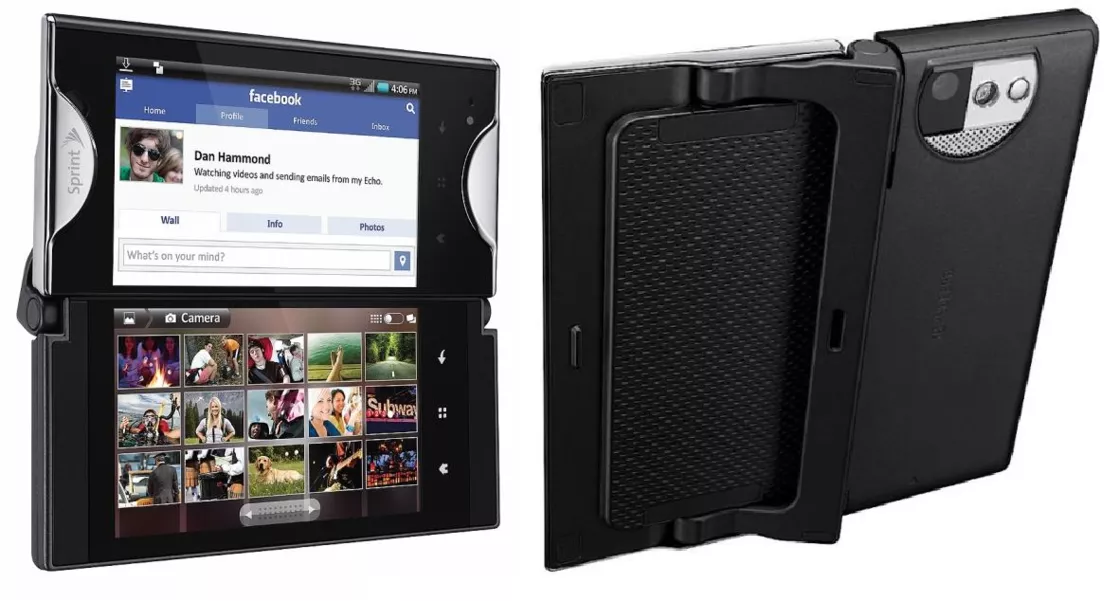 Heft is synonymous with the Kyocera Echo, and it's clear that a lot of sacrifices were made to cram this sub-screen in. The Kyocera Echo's secondary screen is mainly used for two purposes: extended display and multitasking, but neither of these two functions integrated into the secondary screen are fully optimized and developed. In terms of extended display, since the Kyocera Echo is still a smartphone released in 2011, although Kyocera has optimized the ratio of the width of the bezel on both sides by moving the screen horizontally, the physical dividing line between the two screens when they are combined in extended display mode is still impossible to ignore, so the content that is blocked is not really small. In terms of multitasking, the Kyocera Echo's performance is really poor, and the 2011 Android system is not prepared for dual-screen display, the display content of the primary and secondary screens basically can not interact, although Kyocera has made some adjustments to the system software, but the lack of third-party application support is still a gap that is difficult to overcome.
Heft is synonymous with the Kyocera Echo, and it's clear that a lot of sacrifices were made to cram this sub-screen in. The Kyocera Echo's secondary screen is mainly used for two purposes: extended display and multitasking, but neither of these two functions integrated into the secondary screen are fully optimized and developed. In terms of extended display, since the Kyocera Echo is still a smartphone released in 2011, although Kyocera has optimized the ratio of the width of the bezel on both sides by moving the screen horizontally, the physical dividing line between the two screens when they are combined in extended display mode is still impossible to ignore, so the content that is blocked is not really small. In terms of multitasking, the Kyocera Echo's performance is really poor, and the 2011 Android system is not prepared for dual-screen display, the display content of the primary and secondary screens basically can not interact, although Kyocera has made some adjustments to the system software, but the lack of third-party application support is still a gap that is difficult to overcome.
The Kyocera Echo's secondary screen has been relegated to serving as a desktop stand when playing multimedia content and a virtual keyboard when held horizontally, due to a really bad time. But the phone was a hit with some retro-gaming fans a few years later: for no other reason than the fact that the virtual joystick of the emulator software was displayed on the secondary screen without obscuring the game screen on the main screen.
NEC N-05E
Two years after the introduction of the Kyocera Echo, NEC has launched its own dual-screen phone, the N-05E, which uses a simpler outward-folding solution than the Echo's relatively complex mechanics, with the benefit of further expanding the use of the secondary screen, but at the cost of two films for those concerned about screen scratches, and only if the case is at all protective. The N-05E's hardware configuration is not mainstream compared to that of its regular smartphone contemporaries: the same MSM8960 processor as the 2011 Xiaomi phone 1 can barely handle two qHD resolution screens for everyday use, but it's a bit overwhelming in high-load scenarios such as gaming, so perhaps Kyocera didn't have a clue about the sales of this product, and chose a two-year-old flagship as a test run. In other words, if the Kyocera Echo could be replaced with the MSM8960, it would be a killer - but unfortunately it can't be.
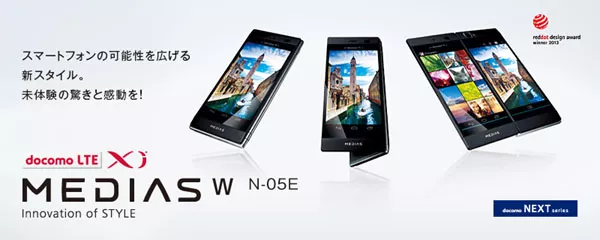 The N-05E looks closer to the foldable screen phone we now know as the N-05E's secondary screen is actually the equivalent of the D-side of this phone, with the The biggest advantage of having the main camera on the same side is that users can use the camera with the best image quality for selfies and have a live preview of the shot on the secondary screen. In addition to extended display and multitasking, the N-05E is also designed with a mirroring mode called "W Movie" for presentation and sharing of screen content, which can be activated by folding the phone at an angle and setting it up horizontally from a flat surface, but this feature is more of an add-on than a practical one. The N-05E's weakness is its software and applications, as NEC has designed a custom UI for it, but the applications that support dual-screen hierarchical display and dual-screen multitasking are still only available in the system's pre-built list, so the phone was a hit but not a miss.
The N-05E looks closer to the foldable screen phone we now know as the N-05E's secondary screen is actually the equivalent of the D-side of this phone, with the The biggest advantage of having the main camera on the same side is that users can use the camera with the best image quality for selfies and have a live preview of the shot on the secondary screen. In addition to extended display and multitasking, the N-05E is also designed with a mirroring mode called "W Movie" for presentation and sharing of screen content, which can be activated by folding the phone at an angle and setting it up horizontally from a flat surface, but this feature is more of an add-on than a practical one. The N-05E's weakness is its software and applications, as NEC has designed a custom UI for it, but the applications that support dual-screen hierarchical display and dual-screen multitasking are still only available in the system's pre-built list, so the phone was a hit but not a miss.
ZTE Axon M
Despite the fact that NEC has already flopped once on the road to an outward-folding dual-screen, ZTE has unhesitatingly announced its own dual-screen smartphone, the Axon M. At first glance, the Axon M and the N-05E are not identical, or at least identical: with a near-identical body layout, the Axon M is also a much thinner secondary screen. The Axon M is a lot thinner, at least in the stowed position, and is close to the same level as conventional smartphones of the same era. Other than that, the Axon M is pretty much an N-05E with better hardware and a slightly better software adaptation, not with the latest Snapdragon 835, but at least with the Snapdragon 821, the basic experience is still on par.
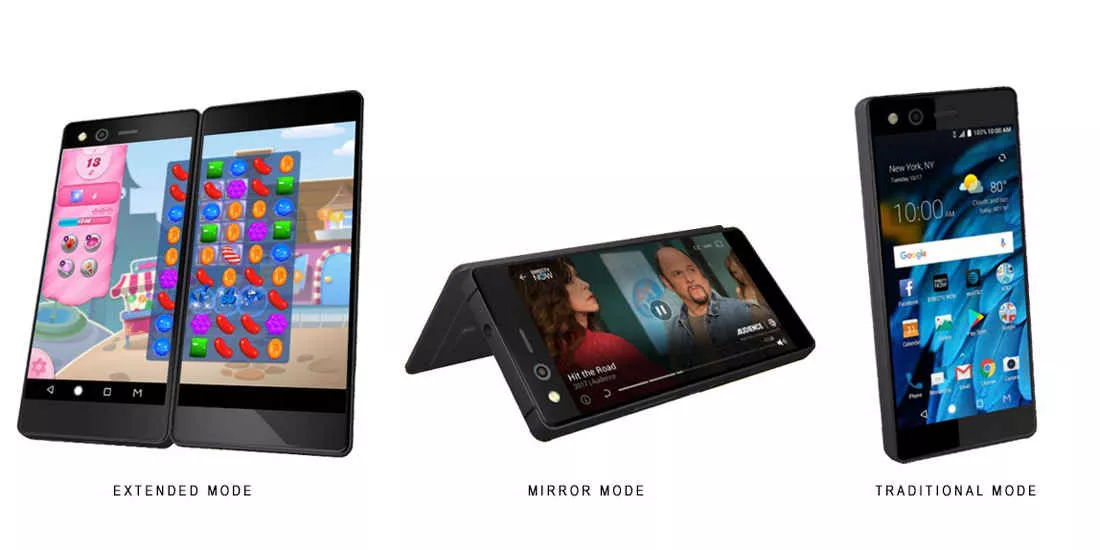 The ZTE Axon M and the NEC N-05E are similar in design, after all, it's hard to find any more innovation in the outward-folding dual-screen design. The Axon M was naturally created as a productivity tool, and the side-by-side dual-screen design does offer unparalleled advantages in text work, but with two screens the Axon M itself is still a small-screen device, and its dual-screen upper limit as a productivity tool is constrained by the size of the single-side screen. Having been in the domestic smartphone market for over a decade, ZTE does understand the importance of good localization, but it really doesn't have much experience with customizing Android, and even MyOS, which has been installed in the last two years, is a stitching monster that cuts everywhere, let alone in 2017. The most unexpected thing is that some popular online games have adapted the Axon M dual-screen even better than the productivity software, so the sexually capable Axon M has not been able to avoid the fate of being a gaming machine in the end, which on the other hand looks like a meritorious achievement, which is to be congratulated.
The ZTE Axon M and the NEC N-05E are similar in design, after all, it's hard to find any more innovation in the outward-folding dual-screen design. The Axon M was naturally created as a productivity tool, and the side-by-side dual-screen design does offer unparalleled advantages in text work, but with two screens the Axon M itself is still a small-screen device, and its dual-screen upper limit as a productivity tool is constrained by the size of the single-side screen. Having been in the domestic smartphone market for over a decade, ZTE does understand the importance of good localization, but it really doesn't have much experience with customizing Android, and even MyOS, which has been installed in the last two years, is a stitching monster that cuts everywhere, let alone in 2017. The most unexpected thing is that some popular online games have adapted the Axon M dual-screen even better than the productivity software, so the sexually capable Axon M has not been able to avoid the fate of being a gaming machine in the end, which on the other hand looks like a meritorious achievement, which is to be congratulated.
Surface Duo
Ever since Microsoft started its Windows Phone and Surface product lines, many users have been fighting for Microsoft's Surface Phone, and the "or paving the way for the Surface Phone" from IT House next door has even become a WP bible for some time. You can see the 'paving the way' in almost any comment section about Windows mobile devices.
Windows Phone failed to beat iOS and Android, and UWP didn't complete the task of unifying the Windows app ecosystem, leaving behind a whole host of unfinished projects that are occasionally "exposed" by people supposedly in the know as tech talk. The only thing that's left is a bunch of unfinished projects that are occasionally "exposed" by people who are supposedly in the know, as the talk of the day for tech enthusiasts. As it turns out, in 2019, Microsoft actually unveiled two new devices at its fall event: the Surface Neo with Microsoft's own Windows 10X desktop operating system, and the Surface Duo with Android mobile OS.
 The Surface Duo opens up like a notebook, and it's designed for just such a purposeThe Surface Neo is instead There's not much to say, after the launch event debut for a round of eyeballs, the concept machine, which was billed as a "future form laptop", was axed by Microsoft's chopper department along with Windows 10X, leaving the concept machine as a concept at the end of the day, while the Surface Duo managed to survive to mass production. Unlike other dual-screen smartphones, the Surface Duo has an inward-facing hinge structure that can't be used without opening, and the concept of its primary and secondary screens becomes blurred, with the subordination of screen functionality only evident from the placement of components.
The Surface Duo opens up like a notebook, and it's designed for just such a purposeThe Surface Neo is instead There's not much to say, after the launch event debut for a round of eyeballs, the concept machine, which was billed as a "future form laptop", was axed by Microsoft's chopper department along with Windows 10X, leaving the concept machine as a concept at the end of the day, while the Surface Duo managed to survive to mass production. Unlike other dual-screen smartphones, the Surface Duo has an inward-facing hinge structure that can't be used without opening, and the concept of its primary and secondary screens becomes blurred, with the subordination of screen functionality only evident from the placement of components.
One of the main reasons for the Surface Duo's unpopularity is that Microsoft's development cycle was so long that it ended up being nearly two generations behind in terms of hardware, and the system software and accessories were so unpolished that the experience offered by both hardware and software didn't match its high price tag. It's somewhere between a smartphone, a tablet, and a thin and light notebook, but doesn't offer the full experience of any of them. In a subsequent update, Microsoft has added dual-screen cloud gaming to the Surface Duo, with the secondary screen above displaying the game screen and the main screen below displaying the Xbox layout with a virtual joystick, which is a step back in time from its predecessors mentioned above.
Quietly rolled inward but always against the grain
On March 15, 2019, Yota Device, founded by a fighting man, declared bankruptcy. The alternative smartphone company launched a total of three major products before going under the radar, and they share a common name: the Yota Phone.
Yota Phone
The original Yota Phone was introduced in 2013, and the Yota Device design team had a simple idea: to protect eyesight and extend battery life by adding an E-INK secondary screen to the back of a traditional smartphone - yes, the original Yota Phone didn't actually have reading as a selling point. The initial Yota Phone was not actually designed to sell reading, but rather to target business people who need to use their smartphones for long periods of time while traveling, so the pricing of the initial Yota Phone was quite "business-like": it started at $600 for a shabby Snapdragon 400 dual-core processor and 2GB + 32GB of storage, not to mention the tiny 2000mAh battery, even if Not to mention the tiny 2000mAh battery, which won't last long even with the power-saving sub-screen all the time.
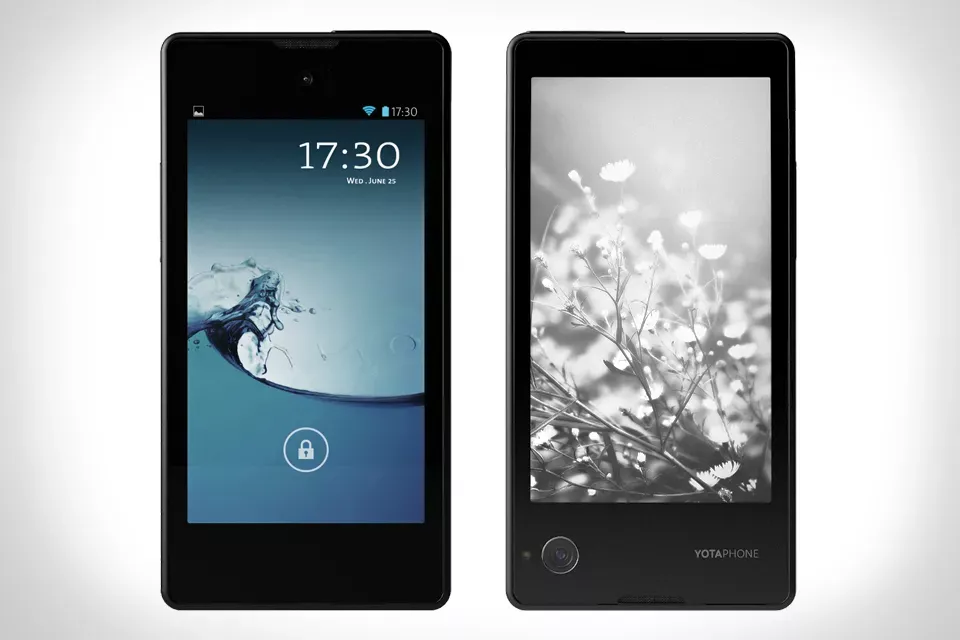 The Yota Phone's secondary screen also squeezes the space that belongs to the main camera, requiring a reverse grip to take a normal picture. The Yota Phone's secondary screen remained an appendage to the main front screen, with little functionality beyond seamlessly switching between displays.Yota Device seems to have realized this awkwardness in the feedback it received after the product's launch, and just a year after the initial product was released, the company quickly launched the Yota Phone 2: changed, but not completely.
The Yota Phone's secondary screen also squeezes the space that belongs to the main camera, requiring a reverse grip to take a normal picture. The Yota Phone's secondary screen remained an appendage to the main front screen, with little functionality beyond seamlessly switching between displays.Yota Device seems to have realized this awkwardness in the feedback it received after the product's launch, and just a year after the initial product was released, the company quickly launched the Yota Phone 2: changed, but not completely.
Yota Phone 2
The Yota Phone 2 has finally matched the mainstream hardware configuration of 2014, and along with the hardware configuration, the utilization of the secondary screen has also improved: the resolution of the secondary screen of the Yota Phone 2 has reached the qHD standard, and with the E-INK material, the look and feel is basically the same as that of paper, avoiding the problems of blurred edges and poor readability of text in the previous generation of 360 x 640 resolution applications. The Yota Device is also a pass mark, and since this generation, reading has been one of the main selling points of the device, with new features such as customizable streams and electronic photo frames on the secondary screen. But all things change, the Yota Phone 2 is still a weak product, and if not for Russian President Vladimir Putin's help at the APEC summit, the series might have stopped there.
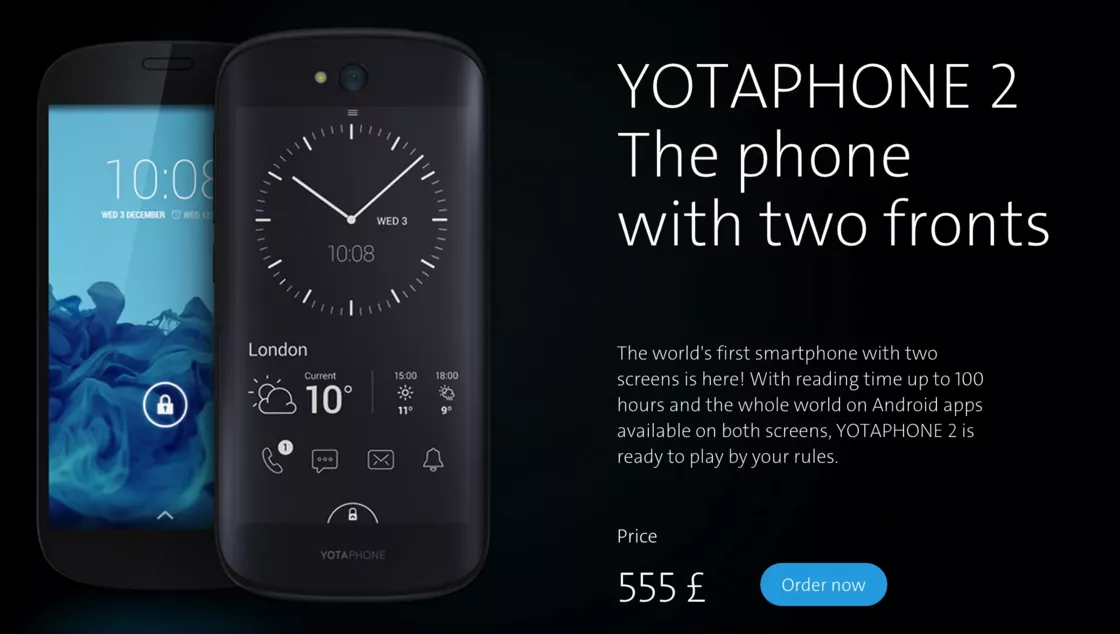 The Yota Phone 2 is still priced at a frighteningly high price, which is actually a result of its small shipments Putin's move to give the Yota Phone 2 The Yota Phone 2 instantly became the top stream of smartphones, and it seems that the product power gap, which took a decade of technology to catch up with, was erased overnight. The most affected by this national marketing campaign in Russia was naturally the Chinese market, and the fever of 'national gift phone' was getting higher and higher in China, Yota Device was rare and keen to smell the scent of opportunity, but for various reasons, Yota Phone 3 was not officially released until September 2017, when the international top stream was no longer Putin the Great, after all, the know-it-all king next door had been in office for more than six months.
The Yota Phone 2 is still priced at a frighteningly high price, which is actually a result of its small shipments Putin's move to give the Yota Phone 2 The Yota Phone 2 instantly became the top stream of smartphones, and it seems that the product power gap, which took a decade of technology to catch up with, was erased overnight. The most affected by this national marketing campaign in Russia was naturally the Chinese market, and the fever of 'national gift phone' was getting higher and higher in China, Yota Device was rare and keen to smell the scent of opportunity, but for various reasons, Yota Phone 3 was not officially released until September 2017, when the international top stream was no longer Putin the Great, after all, the know-it-all king next door had been in office for more than six months.
Yota Phone 3
The Yota Phone 3 has been designed and manufactured for the Chinese market, and the E-INK sub-screen has once again changed its purpose: the design team has cut out the mirroring mode that has been a feature of the Yota Phone since its launch, and the sub-screen can only display pre-defined information instead of directly copying the content from the main screen; adapted Apps that have been adapted can still display some of the information on the secondary screen, but there are very few of them - and yes, it's a miracle that the "small and beautiful" people who can ignore even the Ministry of Industry and Information Technology-led Unified Push Consortium are interested in this unknown phone maker.
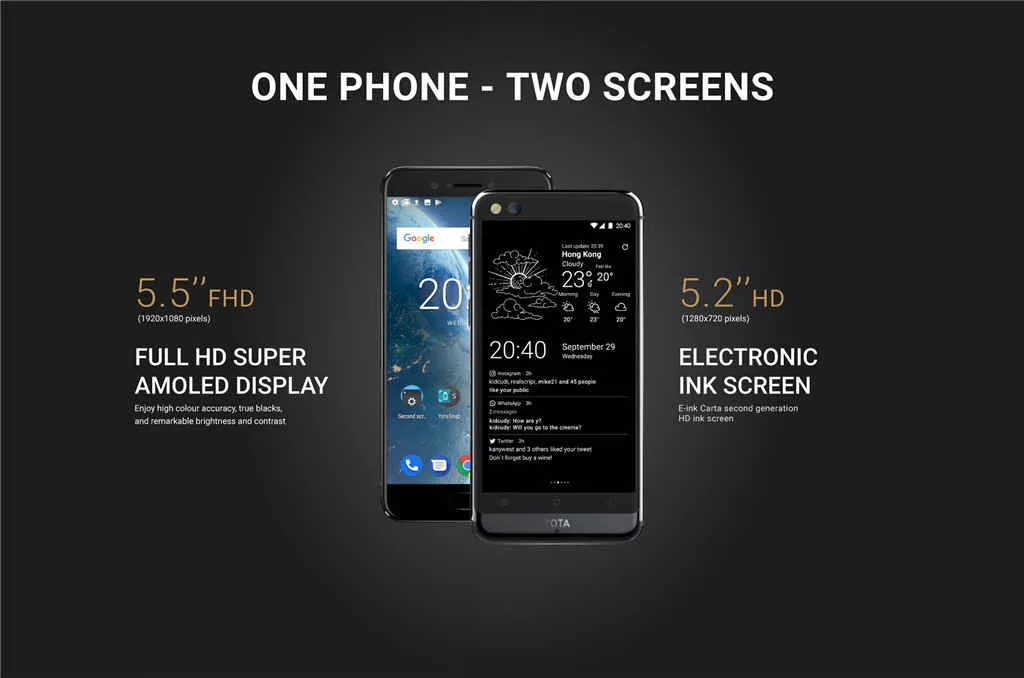 The Yota Phone 3 doesn't have much to offer, and the only thing that can be advertised is that the screen is primarily for reading. The biggest design flaw of the Yota Phone 3 comes from the reading itself - because of the overemphasis on the reading aspect of the secondary screen, the Yota Phone 3's home and secondary screens are almost completely separated, leaving the user with no choice between the device's functions, and only the manufacturer's preset mode of switching between the two screens: reading, or otherwise. It is no exaggeration to say that the Yota Phone 3 is a bundle of smartphone and reader, and its design concept has completely deviated from the original intention; the hardware configuration and software compatibility problems of its predecessor have not only not been solved, but are also driving backwards, and for all these reasons, the Yota Phone's product positioning is therefore gradually distant from the needs of the target user group, and eventually led to the company's bankruptcy The company eventually went bankrupt.
The Yota Phone 3 doesn't have much to offer, and the only thing that can be advertised is that the screen is primarily for reading. The biggest design flaw of the Yota Phone 3 comes from the reading itself - because of the overemphasis on the reading aspect of the secondary screen, the Yota Phone 3's home and secondary screens are almost completely separated, leaving the user with no choice between the device's functions, and only the manufacturer's preset mode of switching between the two screens: reading, or otherwise. It is no exaggeration to say that the Yota Phone 3 is a bundle of smartphone and reader, and its design concept has completely deviated from the original intention; the hardware configuration and software compatibility problems of its predecessor have not only not been solved, but are also driving backwards, and for all these reasons, the Yota Phone's product positioning is therefore gradually distant from the needs of the target user group, and eventually led to the company's bankruptcy The company eventually went bankrupt.
After all, the domestic smartphone market is nothing but Verdun or Somme, and niche brands that don't have enough volume to fight a long-term war of attrition will lose their skin, if not their lives, if they participate in it.
Hisense A6
After the Yota Phone, Hisense also made similar attempts at 'smartphone + reader'. the Hisense A6, released in November 2018, also features an E-INK sub-screen design, which is a bit more cost-effective than the Yota Phone 3 and has made some localization attempts for the domestic market.
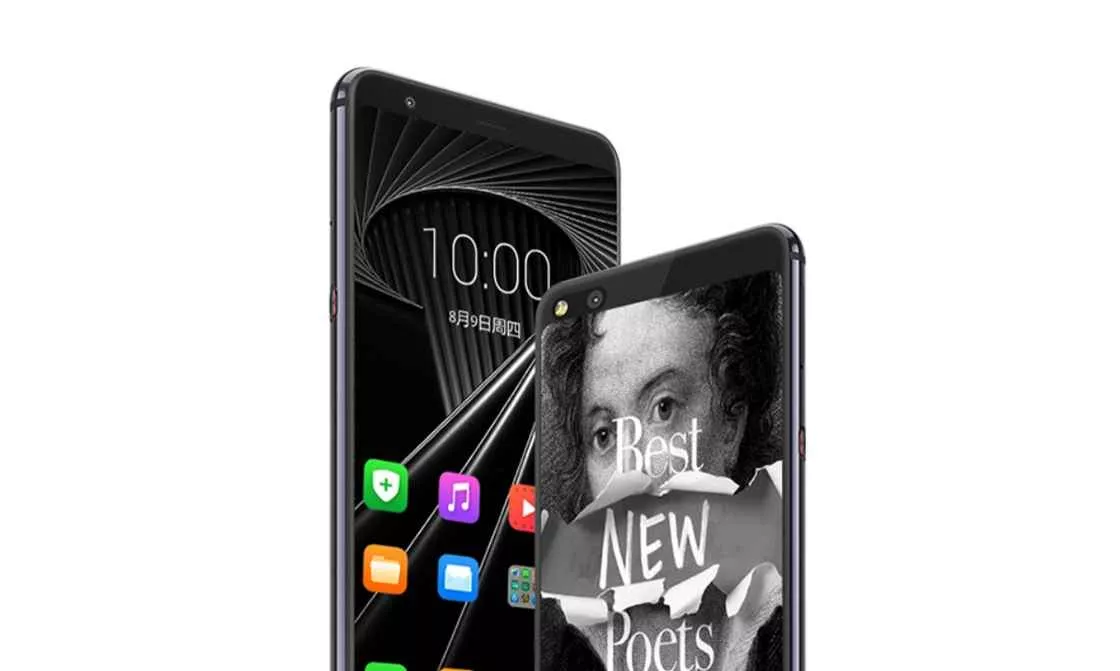 Hisense A6 is better than the Yota Phone, but it has not been able to break out of the circle of self-improvement, although Hisense A6 did make some changes. Although Hisense A6 did make some changes, its market positioning was too "miserable in the mountains and the water", coupled with a series of production capacity, quality control and PR problems, Hisense A6 and its successors failed to break the circle, and failed to make any waves in the fierce smartphone market. In fact, Hisense A6 and Y6 are the most popular smartphones in the world. In fact, the dilemma faced by Hisense A6 and Yota Phone is also a common dilemma faced by niche products, where the difference between satisfying real demand and creating pseudo-demand often lies in the mind of the designer.
Hisense A6 is better than the Yota Phone, but it has not been able to break out of the circle of self-improvement, although Hisense A6 did make some changes. Although Hisense A6 did make some changes, its market positioning was too "miserable in the mountains and the water", coupled with a series of production capacity, quality control and PR problems, Hisense A6 and its successors failed to break the circle, and failed to make any waves in the fierce smartphone market. In fact, Hisense A6 and Y6 are the most popular smartphones in the world. In fact, the dilemma faced by Hisense A6 and Yota Phone is also a common dilemma faced by niche products, where the difference between satisfying real demand and creating pseudo-demand often lies in the mind of the designer.
But where there are a few decent
Most modern smartphones with 'sub-screen' attributes have been flawed in terms of product power, but this is not because of the inclusion of sub-screens, but because the advent of the touch-screen era has allowed for an unprecedented increase in the size and utilization of the front screen of the phone, many of the design differences caused by operations that required the assistance of function keys and keyboards in the past were easily smoothed out by the advantages of large-screen multi-touch, and the sub-screen itself Survival space has been squeezed to almost zero, until the emergence of the folding screen to obtain a new use of the scene.
However, at a time when the secondary screen of mobile phones is dying, there are also manufacturers who try to open a new window of application for it through functional innovation: either make it take over some of the commonly used functions and try to make it as senseless as possible; or simply open the main screen and secondary screen, a "two rabbits walking on the ground, can identify me as male and female" - although these attempts may not all Although these attempts may not all be successful, the products created through these attempts also provide new ideas for the development of the secondary screen, which has high reference significance.
Samsung W2019
From the W699, which came out on December 26, 2008, to the W2019, the conclusion of the entire "Heart to Heart" flip series, the W series from Samsung and China Telecom is probably the closest thing to a traditional dual-screen smartphone. The W series is probably the best known of them, and the W2019 is the best of the flip models in the series.
Normally, the external secondary screen of a flip phone is just a window to access the phone's own shortcut functions, so naturally it can't be too big and too functional, or it'll inevitably overwhelm the main one. The W2019's design does the opposite: the external secondary screen is almost identical to the main screen, with the straight screen when lit up and the flip screen when lifted off the A-side.
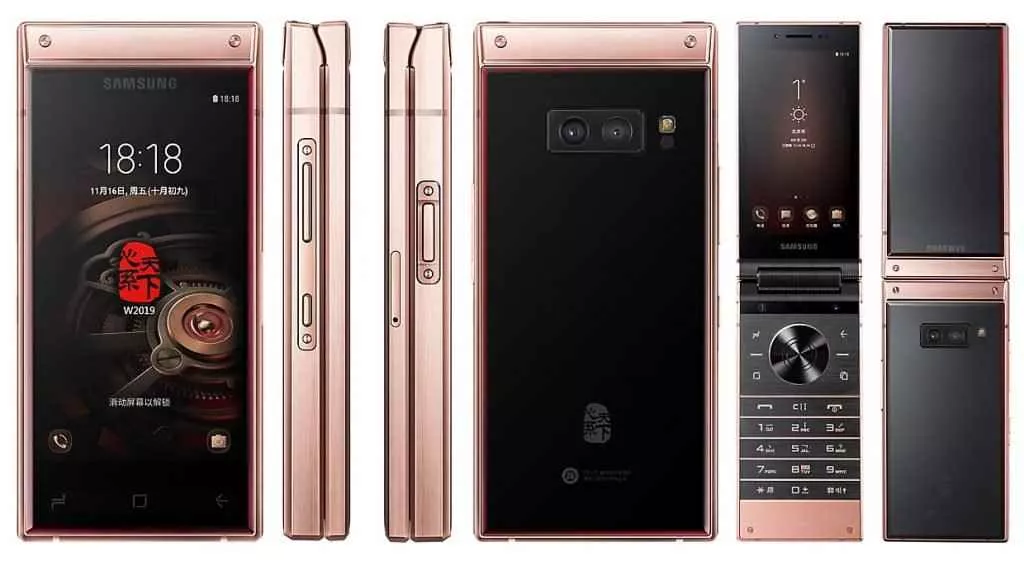 The W series has always been known for its luxurious high-end business image, but the overly middle-aged color scheme has often been greeted with complaints from users Samsung dared to make such a move on the W2019 The W2019 is a Versailles-class product that starts at $18,999, so the cost of an extra screen is a drop in the ocean for its premium price. The W2019's users usually pay more attention to the design, material quality and daily use of the smartphone, so the secondary screen is naturally as close to the main screen as possible, from the parameters to the functions, and what kind of tricks it can do is not a priority.
The W series has always been known for its luxurious high-end business image, but the overly middle-aged color scheme has often been greeted with complaints from users Samsung dared to make such a move on the W2019 The W2019 is a Versailles-class product that starts at $18,999, so the cost of an extra screen is a drop in the ocean for its premium price. The W2019's users usually pay more attention to the design, material quality and daily use of the smartphone, so the secondary screen is naturally as close to the main screen as possible, from the parameters to the functions, and what kind of tricks it can do is not a priority.
Phantom Pro7
In the years after the breakup with Qualcomm, Meizu has been on the road of "polishing" MediaTek chips, not only in the entry-level Meilan to achieve the "chip is permanent, one will always flow", even its own flagship model Meizu Pro6 is the same MediaTek X25 processor next door to the Redmi Pro, even if the users do not have a problem, Meizu's own face is also a bit embarrassed. The standard version of the processor was also reversed, from the X25 on the Pro6 to the P25 on the $1,000 machine, and the high end version was only given an X30, which is enough to see Meizu's dilemma back then.
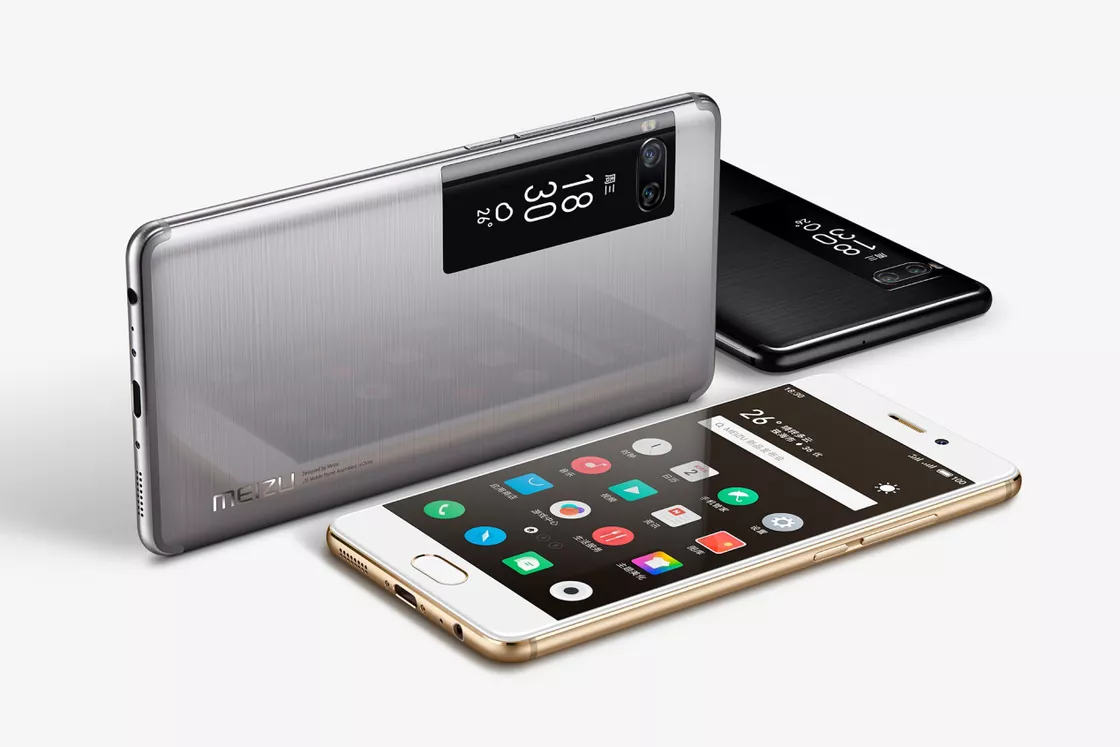 The back of the Meizu Pro7 looks like a ...... refrigeratorIn order to stack as many selling points as possible on the In order to pile as many attractive selling points as possible on the limited hardware configuration, Meizu Pro7 has added a 1.9-inch sub-screen on the top left of the back, called the "picture screen", which is integrated with the main camera, this sub-screen is made of AMOLED material, so it can be always on for 24 hours with almost no impact on battery life, thus displaying common information such as date, time, weather, steps and notifications, and also supports It also supports swiping the secondary screen to switch between shooting modes in the included camera app, but otherwise there are no more user customizable options.
The back of the Meizu Pro7 looks like a ...... refrigeratorIn order to stack as many selling points as possible on the In order to pile as many attractive selling points as possible on the limited hardware configuration, Meizu Pro7 has added a 1.9-inch sub-screen on the top left of the back, called the "picture screen", which is integrated with the main camera, this sub-screen is made of AMOLED material, so it can be always on for 24 hours with almost no impact on battery life, thus displaying common information such as date, time, weather, steps and notifications, and also supports It also supports swiping the secondary screen to switch between shooting modes in the included camera app, but otherwise there are no more user customizable options.
The Meizu Pro7 is very restrained in the function of the secondary screen, not because of hardware performance limitations, but because the secondary screen itself is used as a display window for system information, which is designed to help users instantly access the current information they need and the importance of push notifications, in order to minimize the frequency of opening the phone to check simple information, thus increasing efficiency and saving time from the side. The Meizu Pro7's clever design actually disguisedly increases the weight of the secondary screen, however, due to the performance of MediaTek's chip, its overall product power is still relatively low, this piece of humanistic care "picture screen" has become a useless vase, not so much to sing, but also enough to be saddened.
Xiaomi 11 Ultra
At its spring event on March 29, 2021, Xiaomi revealed the Xiaomi 11 Ultra, its most lavishly stacked digital flagship since its inception, and it's odd that the Xiaomi 11 Ultra also has an AMOLED sub-screen integrated into the camera module, but it never makes this sub-screen the focus of its hype.
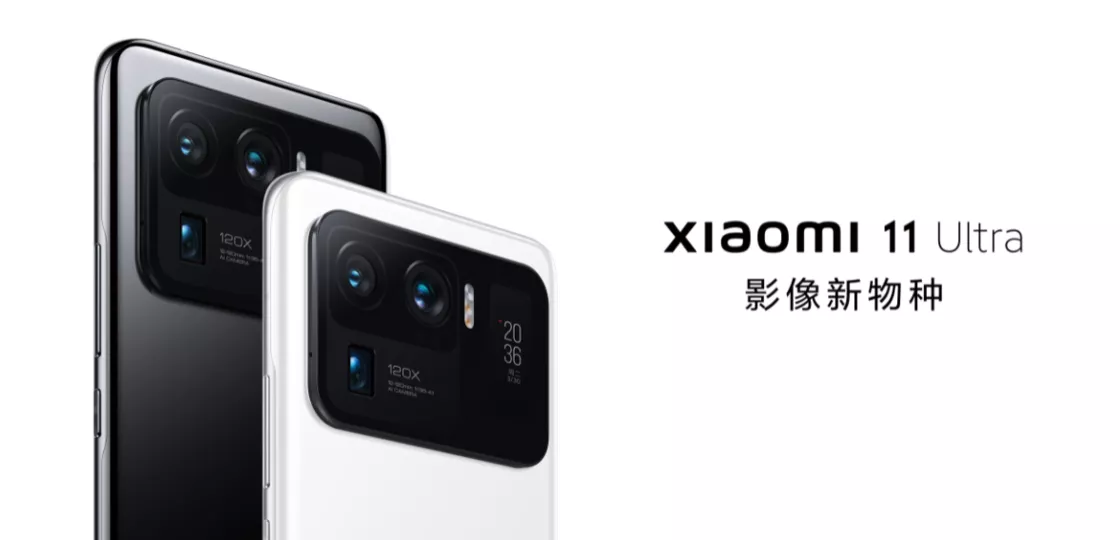 米冲高,关键年...... Xiaomi 11 Ultra's materials are indeed The secondary screen of the Xiaomi 11 Ultra is similar to the secondary screen of the Meizu Pro7 in terms of its main function, but with the support of MIUI, the secondary screen of the Xiaomi 11 Ultra has a high degree of customizability, its decorative and functional basically tied, but otherwise did not develop more ways to play, its existence is more like imposed for the sake of stacking materials, but The screen's ability to serve up the Xiaomi 11 Ultra's emphasis on imaging in the form of a photo preview is a bit puzzling. However, after the launch of the Xiaomi Mix4, the Xiaomi 11 Ultra, which is also a flagship, has established itself as a unique flagship with its secondary screen, thus differentiating itself from the Xiaomi Mix4, which has a very similar design and positioning, thus preventing its products from being in the same room in a similar price range. That's probably the biggest point of the Xiaomi 11 Ultra's bracelet-like secondary screen.
米冲高,关键年...... Xiaomi 11 Ultra's materials are indeed The secondary screen of the Xiaomi 11 Ultra is similar to the secondary screen of the Meizu Pro7 in terms of its main function, but with the support of MIUI, the secondary screen of the Xiaomi 11 Ultra has a high degree of customizability, its decorative and functional basically tied, but otherwise did not develop more ways to play, its existence is more like imposed for the sake of stacking materials, but The screen's ability to serve up the Xiaomi 11 Ultra's emphasis on imaging in the form of a photo preview is a bit puzzling. However, after the launch of the Xiaomi Mix4, the Xiaomi 11 Ultra, which is also a flagship, has established itself as a unique flagship with its secondary screen, thus differentiating itself from the Xiaomi Mix4, which has a very similar design and positioning, thus preventing its products from being in the same room in a similar price range. That's probably the biggest point of the Xiaomi 11 Ultra's bracelet-like secondary screen.
There'll be a few who want to get into trouble.
There are so many smartphone manufacturers out there, and a few unusual products pop up every once in a while. Ten years ago, the mobile phone market is still in sight, the scene of the vibrant, everything is still hair, and now the smartphone almost to the ceiling of the consumer electronics hardware, since the function of the same way has been inevitable, then the form of the parting of the ways to do it is indeed easier.
LG G8X ThinkQ
South Korea used to have three major smartphone manufacturers: Samsung, LG and Pantech, but now only Samsung is left alone. If you look at the weird and wonderful smartphones these three have made, LG, the second-best of them all, is definitely one of the best. Starting with the LG V50 ThinkQ, LG seems to have a strong and strange obsession with dual screens, so much so that after launching its flagship G8 ThinkQ on March 29, 2019, LG launched the G8X ThinkQ just six months later, a new model that can be considered an all-around scaled-down model compared to the earlier G8 ThinkQ, but was once hotter than the G8 The G8X ThinkQ was launched just six months after the G8 ThinkQ.
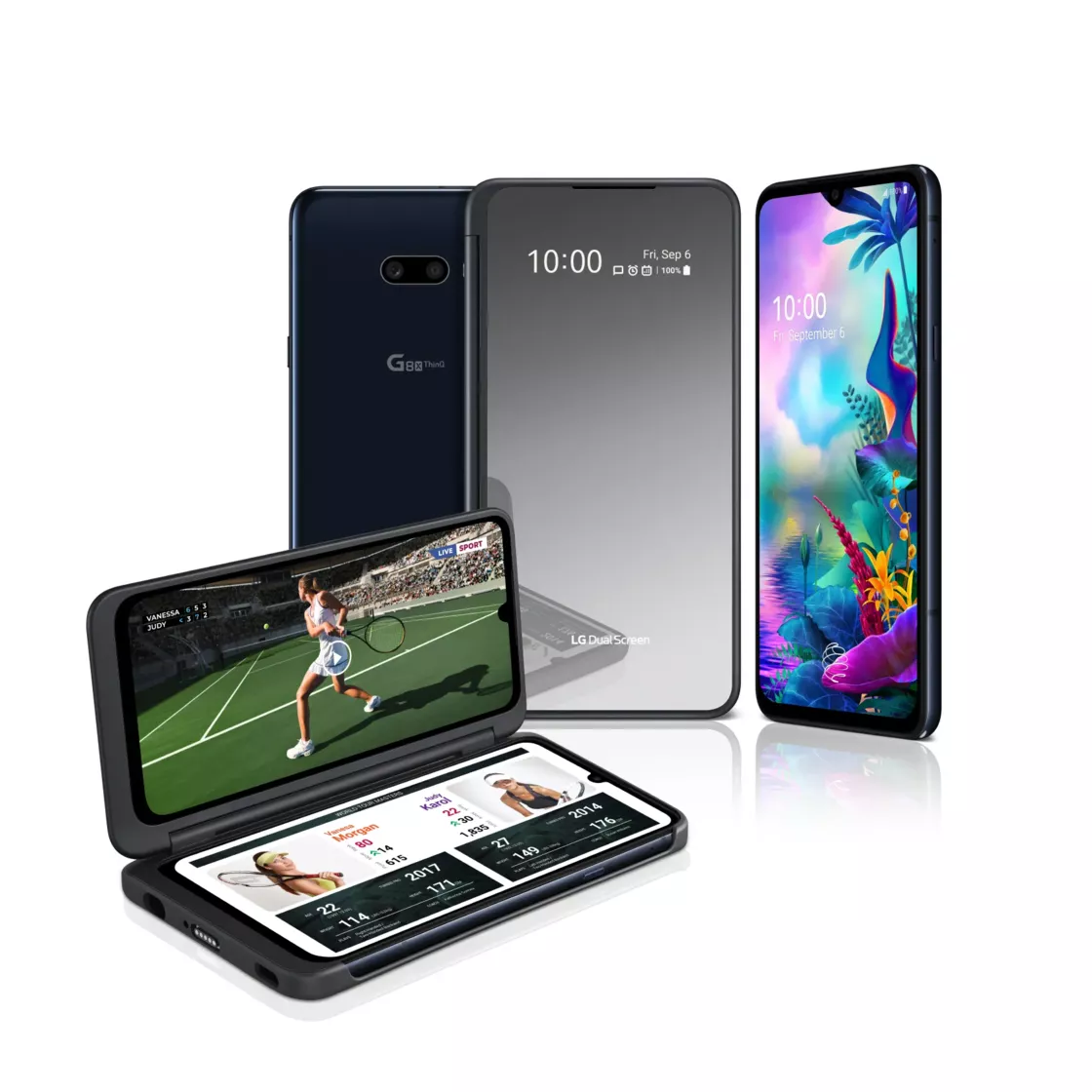 The stitched dual screen also counts as a dual screen, as the LG Dual Screen is not an optional accessory, but is sold as a bundle with the body of the phone LG Dual Screen is actually the official secondary screen accessory for the G8X ThinkQ, and it consists of two screens: a secondary screen that is identical to the one that comes with the phone, and a small screen that comes with the case to display simple information such as the time and date and push notifications, and can also be used to answer incoming calls without opening the A-side. The full G8X ThinkQ is almost like having a small screen on the A-side of the Surface Duo, with a 360-degree hinge that allows it to fold both outward and inward, and a relatively complete set of adaptations and optimizations for third-party apps; the gaming experience remains a major test for the dual-screen phone, but the G8X ThinkQ's hardware is at the level of a 2019 flagship. The G8X ThinkQ's hardware configuration is at the 2019 flagship level, so high load scenarios won't put too much pressure on performance release.
The stitched dual screen also counts as a dual screen, as the LG Dual Screen is not an optional accessory, but is sold as a bundle with the body of the phone LG Dual Screen is actually the official secondary screen accessory for the G8X ThinkQ, and it consists of two screens: a secondary screen that is identical to the one that comes with the phone, and a small screen that comes with the case to display simple information such as the time and date and push notifications, and can also be used to answer incoming calls without opening the A-side. The full G8X ThinkQ is almost like having a small screen on the A-side of the Surface Duo, with a 360-degree hinge that allows it to fold both outward and inward, and a relatively complete set of adaptations and optimizations for third-party apps; the gaming experience remains a major test for the dual-screen phone, but the G8X ThinkQ's hardware is at the level of a 2019 flagship. The G8X ThinkQ's hardware configuration is at the 2019 flagship level, so high load scenarios won't put too much pressure on performance release.
However, the dual-screen G8X ThinkQ is 1.5cm thick and weighs 346g, so you have to unfold it when using it; the LG Dual Screen itself has no battery and needs to be plugged into the G8X ThinkQ's Type-C port to work, so the phone's 4000mAh battery has to power two 6.4-inch 2K screens at the same time. That's almost a discount on the battery life, and it doesn't look like it's going to be able to handle daily use. Most users of the G8 ThinkQ will choose to remove the Dual Screen accessory after the novelty wears off, and LG admits that dual-screen phones need to be used for a long time to form a fixed mode of operation before they can become popular. LG's attempt at a new dual-screen form factor was inevitably a failure.
Motorola Razr 2019
The Razr "Blade" has always been Motorola's proud line of high-end ultra-thin phones, starting with the Razr V3 in 2004, to the Android era Droid Razr's stunning explosion - several changes of hands, Motorola has not forgotten the past even under the roof of Lenovo The glory days of a call to action. With the rise of folding screen technology, Motorola has also toyed with the idea of replicating the Razr's classic flip model. This plan finally became a reality on November 14, 2019 - the Razr 2019 announced the return of the series with a new folding screen form factor.
Unlike its folding screen contemporaries, the Razr 2019 does not choose to take advantage of the folding screen feature to compress the size of the tablet into the phone, but instead does the opposite by folding the phone vertically to further reduce the size of the phone, maximizing portability in the stowed state while also ensuring the overall thinness of the body once unfolded.
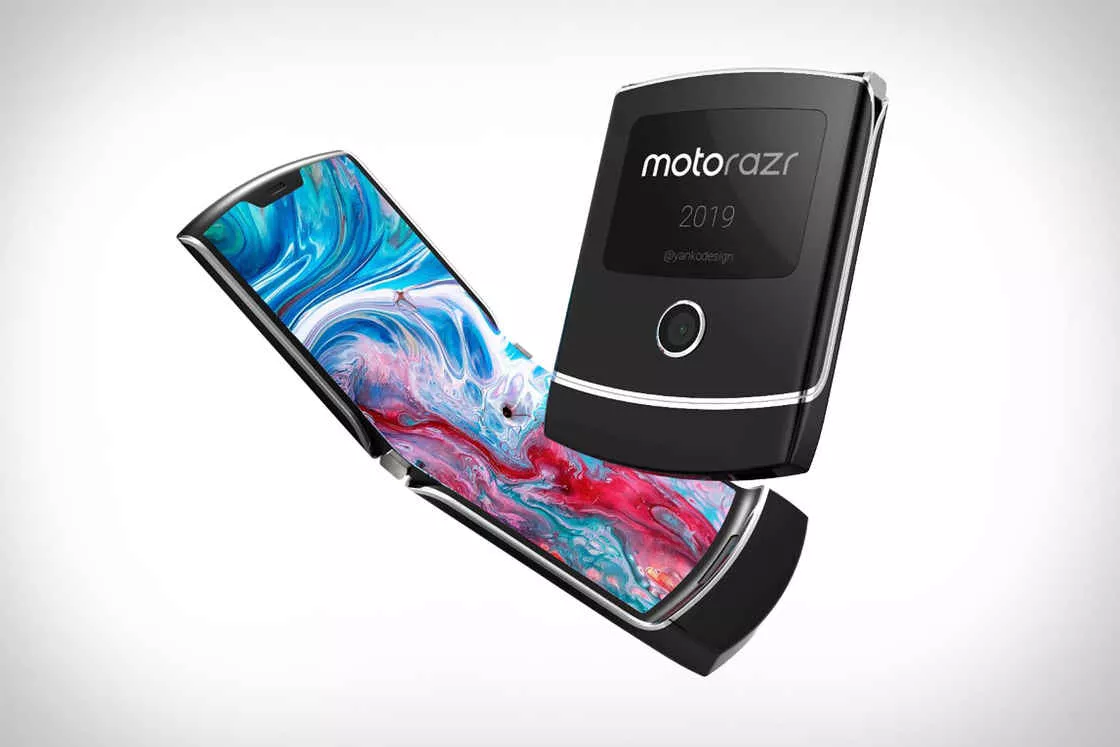 The Razr 2019 is the world's first smartphone to replicate the flip shape with folding screen technologySimilar to traditional flip phones, Motorola has also designed a secondary screen on the A-side of the Razr 2019 called Quick View. The Razr 2019 also features a secondary screen called Quick View on the A-side, which is true to its name and has no obvious shortcomings compared to the similarly positioned secondary screens on the Meizu Pro7 or Xiaomi 11 Ultra above. On top of that, the Razr 2019 comes with a set of preset themes built into the Razr V3.
The Razr 2019 is the world's first smartphone to replicate the flip shape with folding screen technologySimilar to traditional flip phones, Motorola has also designed a secondary screen on the A-side of the Razr 2019 called Quick View. The Razr 2019 also features a secondary screen called Quick View on the A-side, which is true to its name and has no obvious shortcomings compared to the similarly positioned secondary screens on the Meizu Pro7 or Xiaomi 11 Ultra above. On top of that, the Razr 2019 comes with a set of preset themes built into the Razr V3.
If the folding screen and sub-screen are the Razr 2019's obsession, everything else on this machine can be seen as a compromise. As a business flagship that will be released in late 2019 and shipped in early 2020, and priced at $1,500 to start with, the Razr 2019 is powered by only the Snapdragon 710 processor that is common on $1,000 phones in 2018, and the battery capacity is reduced to 2,510mAh due to the drastic reduction in thickness. It's still essentially a gimmick rather than a practical 'sentimental' product.
LG Wing
Twelve years after the 2008 Marvel superhero movie Iron Man starring Robert Downey Jr. brought LG's swivel-screen phone, the VX9400, LG picked up the swivel-screen design again on September 15, 2020, and kept up with the times by replacing the keyboard area below the screen with a secondary screen. This dual-screen arrangement was also seen on LG's earlier side-sliding Android smartphone, the C729, but due to the hardware configuration at the time, the secondary screen on the C729 only served as an additional docking station, while the LG Wing's secondary screen could do a lot more.
 The LG Wing has such a unique look that it's almost a once-in-a-lifetime kind of thing.The LG Wing may not be the best dual-screen phone, but it's certainly one of the best dual-screen phones out there. The LG Wing's T-shaped appearance when unfolded provides a comfortable grip and a wide landscape view, and the large secondary screen can also act as a camera head in landscape shooting mode, making the LG Wing's secondary screen actually more of a service to the imaging system than the Xiaomi 11 Ultra's design. The main camera parameters of the Wing are not particularly impressive for a flagship in 2020, but the Snapdragon 765 processor has a better ISP performance and offers additional AI-based features including AR effects and focus radio, making it attractive for vloggers.
The LG Wing has such a unique look that it's almost a once-in-a-lifetime kind of thing.The LG Wing may not be the best dual-screen phone, but it's certainly one of the best dual-screen phones out there. The LG Wing's T-shaped appearance when unfolded provides a comfortable grip and a wide landscape view, and the large secondary screen can also act as a camera head in landscape shooting mode, making the LG Wing's secondary screen actually more of a service to the imaging system than the Xiaomi 11 Ultra's design. The main camera parameters of the Wing are not particularly impressive for a flagship in 2020, but the Snapdragon 765 processor has a better ISP performance and offers additional AI-based features including AR effects and focus radio, making it attractive for vloggers.
For applications that are not optimized for dual-screen mode, the LG Wing also offers a better set of adaptations: both screens support Android gestures for quick operation in unadapted common applications; in applications that play multimedia content, the secondary screen is generally used as a control to display the media content; and in games that are not equipped with a virtual joystick, the secondary screen is used to display LG's Game Toolbox to adjust the performance release and game frame rate in real time. The LG Wing provided yet another new idea for smartphone form factor development, but unfortunately LG officially announced its withdrawal from the smartphone market on April 5, 2021, and the LG Wing was never seen again after only six months of release.
Write at the end
Have smartphones lost their innovative power? After phasing out the navigation keys, trackball, capacitive touch screen and other traditional operation methods, the modern smartphone, which fully serves the multi-touch operation of the straight form has been proven to be the optimal solution before the next breakthrough in human-computer interaction technology innovation emerges, plus manufacturers and users have accepted and agreed to the existing form of smartphones, so the first to make innovations in the appearance of the phone manufacturers just want to It is already difficult to convince users to change their perceptions.
On the other hand, the almost insurmountable fragmentation of the Android system has also led to a sharp increase in the hidden costs of technological innovation in smartphones, so that software updates often fail to keep up with hardware innovations. Hardware manufacturers often have to look at software developers when it comes to the adaptation of third-party applications, and the need for mobile phone manufacturers to "cooperate" with certain popular online games to unlock high graphics and high frame rate options is the most common case of malicious restrictions on technological innovation and interference with market competition by Internet giants today.
It seems that the development of smartphones has gradually shifted from straightforward cosmetic and functional innovation to subtle conceptual and detailed innovation, and manufacturers are more used to adding modifications to existing frameworks rather than making differences for the sake of making differences, thus avoiding unwarranted cost increases and wasted resources. With technologies such as AI algorithms, 5G networks and the Internet of Everything, the smartphone has transformed from a digital tool to a necessity in modern society, and the way we use it is very different from a decade ago - it hasn't lost its innovative power, it's just that this innovation has been integrated into our lives, becoming imperceptible due to its ubiquity. It's just that this innovation has been integrated into our lives, becoming imperceptible due to its ubiquity.